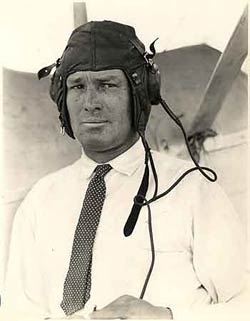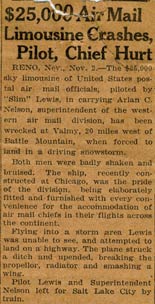Harold Turner "Slim" Lewis, Date Unknown (Source: Smithsonian)
 |
Unsourced, Undated News Article (Source: Cahill)
 |
It is fair to say that with Slim Lewis we have a pilot’s
pilot. It is also fair to say that, among the pilot
denizens of the Davis-Monthan Airfield Register, he was but
one of many pilot’s pilots. Few of their careers,
however, became folklore to the extent of Lewis’s: part
jester, part daredevil, all pilot.
Slim Lewis was a pioneer air mail flyer who has a good Web
presence based on his exploits (you’ll find a couple
of hundred hits when you Google “Slim Lewis”). A
nice biography (with music) is here. On the same site is an image, here. And
this link for
Smithsonian information and images of Lewis (right).
At left, an undated article (ca. 1921) commemorates the beginning of air mail service, mentioning Lewis in the last paragraph along with fellow pilot and air mail legend Jack Knight. Lewis flew the Omaha, NB to Cheyenne, WY segment of the transcontinental route.
Besides his U.S. airmail service, Lewis left his marks flying
for Boeing Air Transport Co., United Airlines, and later
as Chief Pilot establishing and operating the Trans Canada
Air Transport system.
Lewis visited Tucson once, landing solo on March 19, 1929
at 11:30 AM. He was flying a Boeing Model 95, NC192E. Based
in Cheyenne, WY he arrived from El Paso, TX. He departed
Tucson westbound to Yuma, AZ at 2:45 PM suggesting, perhaps,
he enjoyed lunch or a bull session at Tucson.
Please follow this link to the Cosgrove Collection to
see three images of NC162E on the ground at Tucson. From the images, it was a cloudy
day on March 19th, probably a good day to hang out and have
lunch or talk for a while. The person in the cockpit is unidentified
in these images, but it is probably not Lewis, who wouldn't
have been wearing a fedora in an open cockpit airplane, at
altitude, in March. The logo on the side of his airplane
shows Lewis was still flying under Boeing Air Transport livery
at the time of his visit to Tucson. Note the "U.S.
Airmail CAM 10" lettering on the vertical stabilizer. Boeing
Air Transport later became United Air Lines. During
1929 Lewis became chief pilot of United’s western division.
Unsourced & Undated News of Crash (Source: Cahill)
 |
Lewis had his share of incidents flying for the mail. Most of them had to do with forced landings in out of the way places, like described in the undated news article, left. See other examples, below.
Unsourced News Article, September 7, 1927 (Source: Cahill)
 |
Lewis began his flying career in 1916 and ended it abruptly
in 1947, when he retired to his Wyoming ranch. His
reasoning? All those instruments and dials in cockpits
had made the seat of his pants just a piece of cloth; all
the fun had gone out of flying. After retirement from
aviation, he ran successfully his 27,000 acre ranch for almost
20 years. Harold Turner Lewis was born
October 3, 1894 at Woodville, CA. He passed away
July 25, 1965, in Cheyenne, WY. His
mother, 93 survived him in Los Angeles. Longevity ran on the female side of Lewis' family. Above, right, an article dated September 7, 1928 documents a flight taken by Lewis with his grandmother who was 82 at the time.
Very little mention was made of his passing in 1965. Almost
a year later the Denver Post Empire Magazine (reference,
left sidebar) published a retrospective article about him.
The author described him as mechanically inclined early in
his life. He devoured Popular Mechanics magazine
and tinkered with mechanisms from washing machines to automobiles.
He worked at whatever jobs he could, including driving mules
on a ranch. And he saved his money. He bought a used Dodge
that he tuned up so he could race around the Tulare, CA area
at 60 MPH, a considerable speed in the early 20th century. Cars
were too slow for him, so in 1916 he sank his savings into
flying lessons, and thus began the lore.
One of the tales
concerns his first solo flight in 1916. There was doubt that
the engine in the Curtiss Pusher was producing enough power.
To check it, Lewis attached a scale between the airplane's
tail
and a post. He set the engine at full power and read 320
pounds on the scale. That seemed like plenty of power, so
he took off.
Undated News, Army Enrollment (Source: Cahill)
 |
In 1918 he taught flying at Lake Charles, LA and tested
Dehavilland DH-4 aircraft for the Army at Dayton, OH for
WWI service. Undated article, right, documents his joining the Air Corps.
After the war he continued flying DH-4s, but
in the employ of the U.S. Post Office. On July 1, 1924 Lewis
flew the first night mail flight between Cheyenne, WY and
Omaha, NB. In 1927 when the Post Office Dept. contracted
airmail to private companies, Lewis flew the Cheyenne to
Omaha run for Boeing Air Transport. In 1934, after becoming
United's Chief Pilot he was transferred to Oakland, CA in
the same position.
According to the Empire Magazine Elrey
B. Jeppesen of Denver
recalled his first encounter with Lewis. Jeppesen drove from
Oakland to Reno, NV in 1929 to see Lewis about an airmail
job. "I was just a kid, and kind of timid, " Jeppesen recalled.
"Slim Lewis was already a famous guy. I found him -- all
6 feet 4 1/2 inches of him -- in a smoke-filled room at
the airport, playing poker with a bunch of pilots. I told
him I wanted a job. He looked me over a little, asked a
couple of questions, and the next thing he told me to get
on the midnight flight to Salt Lake as copilot." Follow
the Jeppesen link to see what came of that.
Lewis was also pals with Register pilot Charles Lindbergh, who, before his trans-Atlantic flight, was among the cadre of pioneer airmail pilots. One article near the time of his flight to Paris was headlined, "LINDBERGH HAS HEROIC COMRADES ON AIRMAIL ROUTE." The article goes on to say, "Any of them would have been glad to take same chance that hero [Lindbergh] took."
Empire Magazine goes on to say, "Lewis believed that the
seat of his pants was the most dependable flight instrument
in the world and that the best way to get from one place
to another was to follow the railroad tracks. Low cloud ceilings
could be avoided by flying closer to the tracks." About this
Lewis once said to a reporter, "An instrument panel is just
something to clutter up the cockpit and distract your attention
from the railroad or river bed you're following." Be that
as it may, during WWII Lewis test-flew B-29 bombers that
had prodigious instrument panels.
He believed early-day pilots extended their life expectancy
by learning to land in a pasture when weather closed in (as
opposed to learning to fly by instruments). He made such
an emergency landing once and rammed into the kitchen of
a farmhouse. He and assorted local manpower pulled the airplane
out, he ordered and installed another propeller and flew
the airplane back to base when the weather was better. He
also hit a bull one time.
Lewis applied his knowledge of pilot tricks to his job as
Chief pilot. Two particular pilots phoned Lewis repeatedly
that they were holed up at back country ranches because
of bad weather. Lewis became suspicious when these reports
started coming from an area where the routes of the two pilots
crossed. Lewis hopped into an airplane and presently spotted
two Boeing 40s in a pasture beneath a cloudless sky. He found
the two pilots with a rancher, in a small cabin playing cards.
The story is that Lewis chewed them out royally, then poured
himself a drink and bought a stack of chips. Lore has it
that Lewis was a shrewd poker player, often carrying five
or six uncashed paychecks to finance his ventures at the
table.
On July 21, 1926 Lewis married Ethel Nimmo after a three-month
courtship. Their friends called them "Slim & Nim".
Primly, Ethel stated, "I didn't ride with Slim in a plane
until after we were married." Afterwards, however, she went
with him on his mail route to Nebraska and nearly froze in
the open cockpit. They landed at North Platte, Lewis wrapped
her feet in newspaper, fed her some coffee and continued
the flight. I have no other record of any flights she might
have taken with him.
The Trans-Canada Airlines job mentioned above came in 1937.
Slim & Nim were stationed at Winnipeg for two years, while
Slim was in charge of flight personnel. Lewis returned to
Seattle and Boeing in 1939 as Chief Pilot. WWII came and
6,000 B-17 bombers and 1,000 B-29 bombers that came from
Boeing's plant were first flown by Lewis and his men before
they went to combat zones. Lewis personally would fly a half
dozen a day. Fellow Register pilot R.P. Tucker was one of the people who worked for Lewis at Boeing.
The close of WWII in 1945 led to Lewis' (slow) decision to
retire from flying. He actually foresaw this turning point,
because he had bought his ranch back in 1939. He stayed on
with Boeing for about a year watching the Stratocruiser commercial
airline program. This was a dull life for Lewis, who had
spent the majority of his flying career in open cockpits,
and more recently, if not more intensely, in bombers. After retirement
Slim & Nim spent their summers in Wyoming (Nim's brother
managed the ranch) and their winters in Palm Springs, CA.
Always an aviator at heart, Lewis enjoyed driving to the
high points of his ranch and overlooking his spread. He didn't
much like horses, so he drove his car most places over his
ranch. During the summer he was intensely into animal breeding
and wheat yields. During the winter he played golf five
days a week.
According to Empire Magazine, friends described
him as modest and never boastful. It was only when old flying
buddies from airmail days came around that he'd ever mention
his exploits and adventures over poker games and liquor through
the night.
Lewis returned from Palm Springs to Wyoming in June, 1965
feeling ill. He went to DePaul Hospital in Cheyenne for six
weeks, suffered a heart attack and died at age 70.
---o0o---
Dossier 2.1.114
UPLOADED: 06/09/07 REVISED: 03/21/09, 04/27/09, 04/13/12
|






